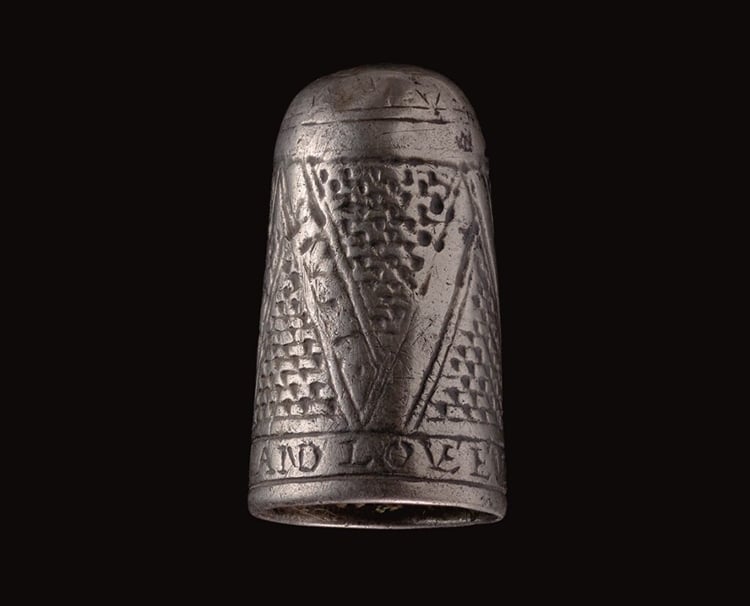
The silver thimble recently discovered. (Photo: National Museum Cardiff)
Sewing is a vital life skill, and before industrial clothing production, it was even more crucial to learn. It can also be a tricky craft; one that many have unintentionally pricked their finger from. And so human kind invented the thimble, a tiny piece of armor for your finger to prevent from pinpricks. A particularly interesting, engraved example was recently unearthed by a man who was out metal detecting in Wales near Carew Castle. The 17th-century silver tool provides insight into the romantic culture of the day.
“I was out detecting under the shade of an oak tree and was having no luck, until I changed the program and found a great crisp signal,” the finder, Rob Edwards, explained in a statement. “At first I thought it may be a sixpence, but to my surprise it was something silver—and not a coin! It wasn’t until later when I saw the similar waffle pattern on another thimble that I knew I had found something special. To be honest, my cousin (who is also my detecting partner) was a little jealous!”
Naturally, this find piqued Edwards’ interest. “I like to think about who used it,” he admits. “Was it used in the castle I could see over the way? Did someone get in trouble when it was lost? I’m very happy that I’ve been able to share it with the rest of you.”
Thimbles are fascinating pieces of history, reflecting craftsmanship and social relations of the day. This particular thimble is made of silver, two pieces soldered together centuries ago. It likely dates to between 1682 and 1740. It bears an incised basket-like pattern all around the word surface. However, most interestingly, it bears an engraving around the base in capital letters: “LYKE STIL AND LOVE EVER.” According to ARTnet's Verity Babbs, the inscription means (in modern parlance) “like enduringly, love forever.” This is a “posy” inscription. These were common decorative motifs on rings, often given between lovers. A thimble, which was part of a woman's essential sewing kit at the time, could be a romantic gift as well.
The thimble, turned over to the government under British treasure laws, will perhaps remain in Wales if a local museum purchases it. From the soil to a museum, it's delightful to see a snippet of a love story from the past.
A thimble, with a sweet and loving engraving, was found by a metal detectorist in Wales—unearthing a love story near the grounds of a castle.

A thimble-maker depicted in 1568. (Photo: Wikimedia Commons, Public Domain)
h/t: [Smithsonian Magazine]
Related Articles:
7,000-Year-Old Canoes Discovered Near Rome Are Oldest Ever Found in Mediterranean
Archaeologists Have Determined What Ancient Roman Wine Tasted Like
700-Year-Old Coin Discovered Depicting Jesus Christ Next to a King
Vatican Museums Open Ancient Roman Necropolis of ‘Via Triumphalis’ to the Public






















































































